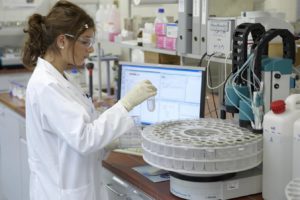 Since its introduction in 1992, the central focus of the Oeko-Tex Standard 100 has been the development of test criteria, limit values and test methods on a scientific basis. From a consumer’s point of view, almost 25 years of experience as a leading international certification system for independent textile substance testing contributes to a high degree of effective product safety. Test criteria and limit values in many cases go beyond applicable national and international standards. Extensive product checks after the certificate has been issued, as well as regular company audits, also aim at ensuring that the industry has a globally sustainable awareness of the responsible use of chemicals. Using its extensive and strict catalogue of measures with several hundred regulated individual substances, the Oeko-Tex Standard 100 not only takes into account important statutory regulations, requirements of Annexes XVII and XIV and the SVHC candidate list for textile products from REACh together with requirements from the US Consumer Product Safety Improvement Act (CPSIA), but also significantly and to a high degree supports initiatives such as the “Zero Discharge of Hazardous Chemicals (ZDHC)” initiative and the “Detox Campaign”.
Since its introduction in 1992, the central focus of the Oeko-Tex Standard 100 has been the development of test criteria, limit values and test methods on a scientific basis. From a consumer’s point of view, almost 25 years of experience as a leading international certification system for independent textile substance testing contributes to a high degree of effective product safety. Test criteria and limit values in many cases go beyond applicable national and international standards. Extensive product checks after the certificate has been issued, as well as regular company audits, also aim at ensuring that the industry has a globally sustainable awareness of the responsible use of chemicals. Using its extensive and strict catalogue of measures with several hundred regulated individual substances, the Oeko-Tex Standard 100 not only takes into account important statutory regulations, requirements of Annexes XVII and XIV and the SVHC candidate list for textile products from REACh together with requirements from the US Consumer Product Safety Improvement Act (CPSIA), but also significantly and to a high degree supports initiatives such as the “Zero Discharge of Hazardous Chemicals (ZDHC)” initiative and the “Detox Campaign”.
Through the continuous work by expert groups in the Oeko-Tex Association and the updates to the Oeko-Tex Standard 100, which take place at least once each year, new scientific innovations and findings are constantly taken into account.
The new test criteria
The new regulations contained therein come definitely into force on 1st April 2016 for all certifications, following a three-month transition period. Supplements or changes were made to the following test parameters in the Oeko-Tex® criteria catalogue:
- Perfluorinated compounds, organotin compounds, softeners/phthalates, pesticides, chlorinated phenols, chlorinated benzenes and toluenes, colourants classified as carcinogenic and which are thus prohibited, polycyclic aromatic hydrocarbons, alkylphenols and alkylphenol ethoxylates as well as flame-retardant substances.
- The new test parameter “UV stabilisers” was also included in Oeko-Tex product class IV.
A complete overview of all amendments and inclusions to the 2016 issue of the Oeko-Tex Standard 100, including a summary of chemical substances, CAS numbers, limit values and background information can be downloaded from the Oeko-Tex website at this link. More information on the new Oeko-Tex test criteria are also available contacting the Oeko-Tex Secretariat (info@oeko-tex.com) or the Oeko-Tex Institutes and representative offices (www.oeko-tex.com/institutes).




